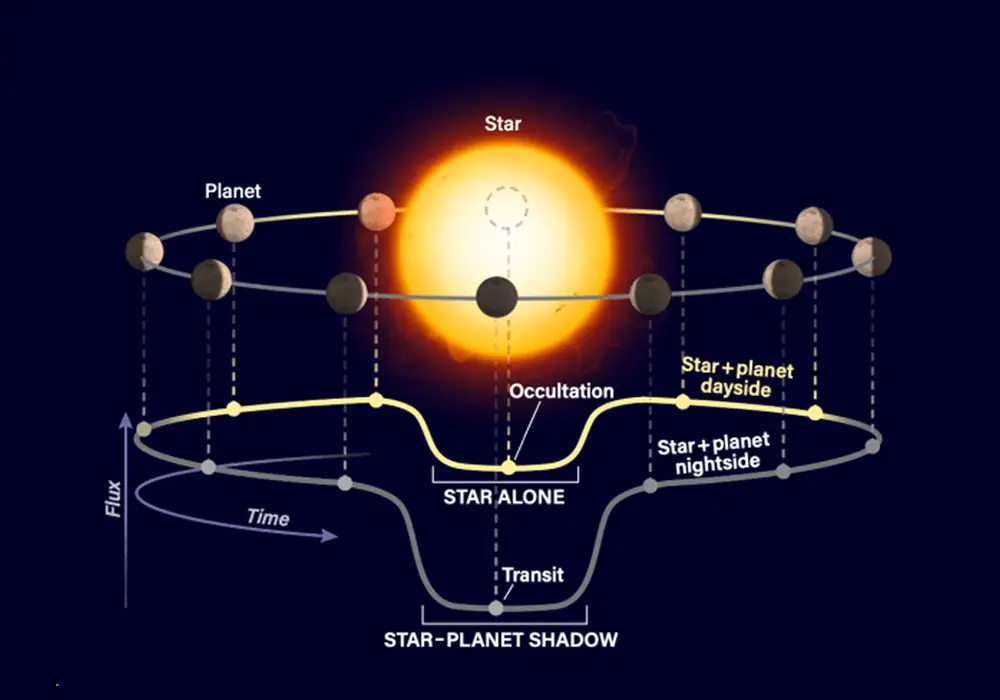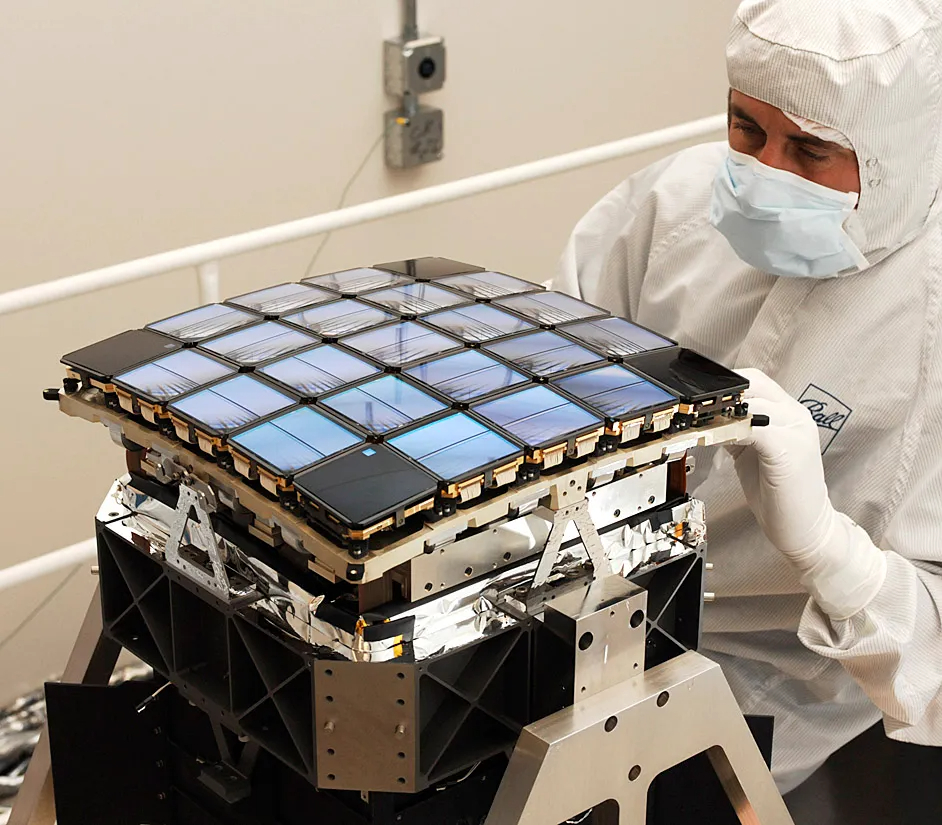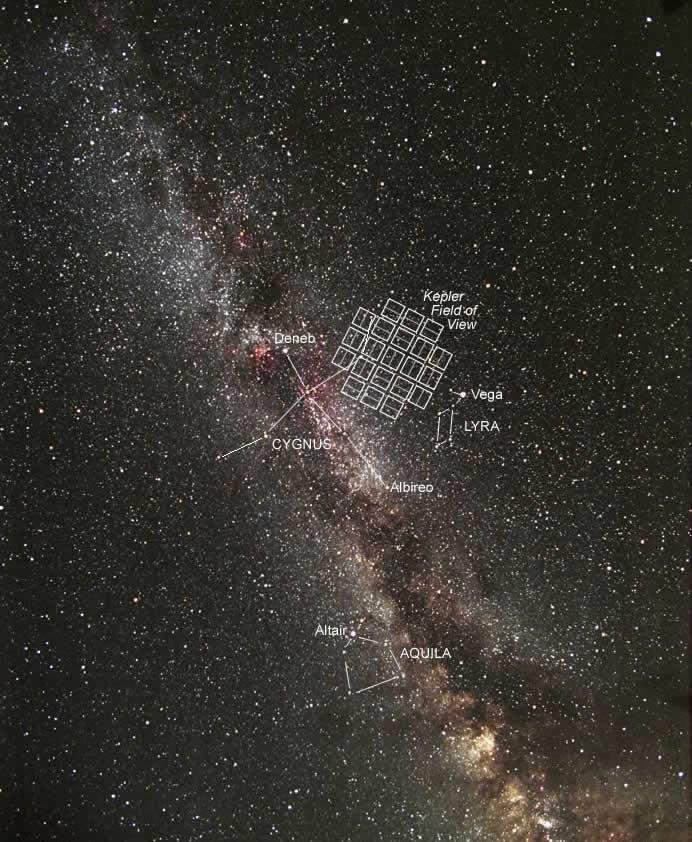Anyone that has spent time looking at the sky, has likely wondered if there is something out there looking back. This millenia old question has driven the development of new imaging technology to explore the cosmos. If found, alien life may help scientists to understand how life arose on Earth about 3.5 billion years ago.

NASA Kepler spacecraft in a clean room at Ball Aerospace & Technologies Corp. in Boulder, Colo. Credit: NASA / Ball Aerospace
The Kepler space telescope was NASA’s first planet-hunting mission focused on finding Earth-sized planets orbiting distant stars. The study of exoplanets – planets outside of our Solar System – helps astronomers understand how solar systems form and to estimate the prevalence of potential life supporting conditions similar to the orbit and composition of the Earth.
The Transit Method
The transit method finds exoplanets by looking for dips in starlight as the exoplanet passes between Earth and its host star. However, this only works when the star and exoplanet happen to line up as we see them from Earth. Because stars and planets are oriented randomly in space, not all exoplanets have orbits that carry them in front of their stars from our point of view. Credit: Astronomy: Roen Kelly
Kepler detected planets by observing transits: the process of a planet passing in front of its host star when viewed from the Earth. This crossing causes tiny dips in the brightness of the observed star of around 84 ppm. While most telescopes would not be able to detect such a tiny change, Kepler was built for high-precision photometry – measuring light curves as a function of time – with a sensitivity equivalent to detecting from space the dimming of a porch light as a person passes in front of it.
Planets in the habitable zone orbiting stars like the Sun complete their orbits in periods of a year to a few years with a very short observable transit time – transit duration – lasting just 2 to 16 hours. Several months or years later, the brightness will dip again as the potential planet repeats its orbit and travels across the star again. If the pattern repeats three or more times, with the same change in brightness and transit duration, the source of the change is likely a planet.
Once detected, astronomers calculated important characteristics of the planet and the star it is orbiting. The planet’s orbit and the mass of the star were determined using a theory developed by Kepler’s namesake: Johannes Kepler's third law of planetary motion. The size of the planet was found from the depth of the transit – how much the brightness of the star drops – and the size of the star. Additionally, the planet’s temperature was calculated according to its orbital size and the temperature of the star – as estimated from the star’s spectral classification. All of these factors can then be used to determine the probability that the planet could support life.
Starspots – darker areas of stars caused by their magnetic fields similar to sunspots on the Sun – will also cause the brightness to dip. An interesting deep-dive into how astronomers accommodate for this can be found on the Planet Hunters blog.
Overcoming Technical Limitations Using Teledyne Technology
The concept of detecting planets through photometry that would eventually morph into the Kepler mission was initially proposed to NASA in 1992 – called FRESIP (FRequency of Earth-Sized Inner Planets). At that time, the review panel determined that while the scientific theory was well founded, the detector technology to support the required precision and low noise to find Earth-size planets did not yet exist. Overcoming this challenge would require improving detector technology; something that Teledyne is forever driving forward.
Additionally, data collected by the Solar and Heliospheric Observatory (SOHO) using a Teledyne CCD47-20 supported a major study on solar variability conducted by the SETI Institute. The study determined that “Earths” around Sun-like stars would be detectable and that enough stars are expected to be as quiet as the Sun.
Eventually, the Kepler photometer concept was approved in the year 2000. After completing a competitive review process, Teledyne was selected as the detector supplier. All that remained was delivering the detectors – more than any other mission had ever asked for, and they had to be excellent.
Photometer Instrument

The 42 CCDs of the Kepler focal plane are approximately one square foot in size. There are four fine guidance modules in the corners of the focal plane that are much smaller CCDs compared to the 42 CCDs used for science. Those smaller CCDs were used to track Kepler’s position and relay that information to its guidance system. Credit: NASA / Kepler mission
Kepler was designed as a giant Schmidt telescope with a 1.4 metres (4 feet, 7 inches) mirror and a 1-metre (3-foot) diameter aperture, and a 95 megapixel sensor array – making it the largest digital camera outfitted for outer space observations at that time. Employing cutting-edge techniques in measuring stellar brightness, Kepler had the sensitivity to detect an Earth-size transit of an mv=12 G2V (solar-like) star at 4 sigma in 6.5 hours of integration. The instrument had a spectral bandpass from .4 - 85 μm.
Kepler used a large focal plane mosaic that was outfitted with 25 modules mounted on a curved surface to optimize the instrument focus, while the modules themselves remained flat. 21 modules – each containing two CCD90s – were optimised for measuring the brightness of stars, with four corner modules used to measure guide stars to maintain accurate telescope pointing. The total focal plane mosaic contains nearly 95 million pixels making it the largest space camera at the time.

In order to have the highest chance of capturing planetary transits, Kepler observed a portion of the Milky Way galaxy; a 115 x 115 degree patch of sky in the Cygnus and Lyra constellation encompassing 150,000 stars. Credit: NASA / Carter Roberts / Eastbay Astronomical Society
Data from the individual pixels that made up each of these 150,000 main-sequence stars were recorded continuously and simultaneously, while the CCDs were read out every three seconds to prevent saturation. Only the information from the CCD pixels where there are stars brighter than about R magnitude of 16 was recorded. The CCDs were not used to take pictures, and the images were intentionally defocused to 10 arc seconds to improve the photometric precision.
In May 2013, the Kepler spacecraft lost the second of four reaction wheels – used to precisely point the spacecraft – effectively ending new data collection for the original mission. However, the detector was still perfectly operational. Engineers designed a solution by using the pressure of sunlight to maintain Kepler’s pointing, like a kayak steering into the current. The redesigned mission – K2 – still hunted for planets, but it scanned a larger swath of sky, shifting its view along the ecliptic plane every three months. K2 lasted as long as the first mission and bumped Kepler's count of surveyed stars up to 530,000.
Discoveries
By extrapolating the results of the small region of the sky surveyed by the Kepler mission, astronomers estimated that our galaxy contains more planets than stars. Some of the billions of hidden planets could be promising places for life. Conservative estimates state that 7% of Sun-like stars host such worlds. However, at the average expected rate of 50%, there could be many more. There are at least four planets with the potential to support life within 30 light-years of our Sun.
Some of the solar systems discovered by Kepler contain many more planets than our own inner solar system. Furthermore, the most common size of planet found by Kepler, doesn’t exist in our solar system: a world between the size of Earth and Neptune. Future missions such as ESA’s PLAnetary Transits and Oscillations of stars (PLATO) – which will be equipped with 104 Teledyne CCD270s – will investigate these planets to help astronomers learn more about them and the structure of the Universe.
Previous estimates about determining the number of potentially habitable exoplanets in our galaxy were heavily based on the planet’s distance from its star. Data collected by Kepler and other missions with a similar focus like MOST and CoRoT, and the estimates of stellar energy output from Gaia, enabled astronomers to calculate how much light hits the planet from its star, which would impact the likelihood that the planet could support liquid water – thus potentially harboring life. The combined information allowed astronomers to investigate the full diversity of stars, solar systems, and exoplanets in the galaxy, thereby assisting in designing future missions to further study exoplanets.
 In July of 2015, Kepler discovered Kepler-452b: the closest analogue to the Earth–Sun system ever found. This artist’s conception of a planetary lineup shows habitable-zone planets with similarities to Earth: from left, Kepler-22b, Kepler-69c, Kepler-452b, Kepler-62f, and Kepler-186f. Last in line is Earth itself. Credit: NASA / Ames / JPL-Caltech
In July of 2015, Kepler discovered Kepler-452b: the closest analogue to the Earth–Sun system ever found. This artist’s conception of a planetary lineup shows habitable-zone planets with similarities to Earth: from left, Kepler-22b, Kepler-69c, Kepler-452b, Kepler-62f, and Kepler-186f. Last in line is Earth itself. Credit: NASA / Ames / JPL-Caltech
When Kepler launched in 2009, fewer than 400 exoplanets had been discovered. Kepler is credited with 5,972 confirmed exoplanets. These range from rocky planets like Earth to giant planets that have densities as low as that of plastic foam. The breakdown of planet types is as follows:
- 2029 - Neptune-like
- 1970 - Gas Giant
- 1747 - Super Earth
- 219 - Terrestrial
- 7 - Unknown
In 2018, Kepler ran out of fuel needed for further science operations. NASA decided to retire the spacecraft within its current, safe orbit, away from Earth.
Works Cited
Hunter, R. C. (n.d.). The Kepler Mission Legacy. NASA Ames Research Center. https://www.nasa.gov/wp-content/uploads/2016/08/the_kepler_mission_legacy.pdf
NASA. (2020, October 29). About Half of Sun-Like Stars Could Host Rocky, Potentially Habitable Planets. https://www.nasa.gov/missions/kepler/about-half-of-sun-like-stars-could-host-rocky-potentially-habitable-planets/
NASA. (n.d.). Kepler / K2. https://science.nasa.gov/mission/kepler/
Niebur S. M. (2023). Renewed Commitment: Kepler. In Brown D. W. (Ed.), United States NASA History Division. NASA’s Discovery Program: The First Twenty Years of Competitive Planetary Exploration. https://lccn.loc.gov/2023003999
Seti Institute. (2020, October 29). How Many Habitable Planets are Out There? https://www.seti.org/news/how-many-habitable-planets-are-out-there/
Teledyne Technologies. (2024, June). The Search for Exoplanets. https://www.teledyne.com/digital-imaging-space-science-monthly/the-search-for-exoplanets
